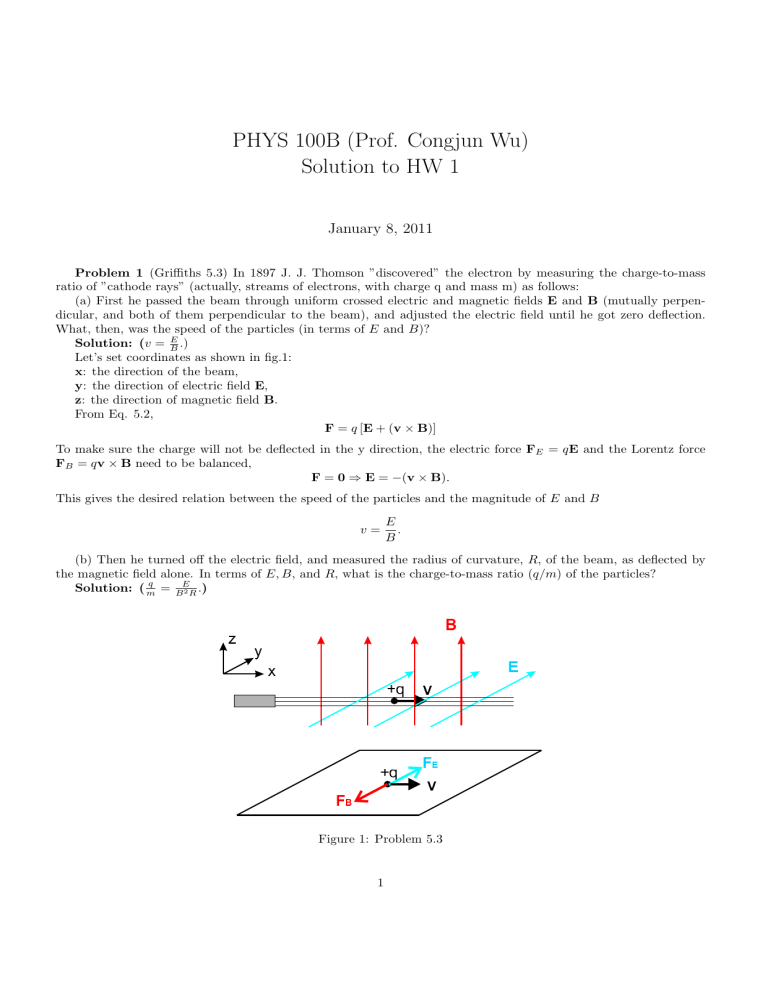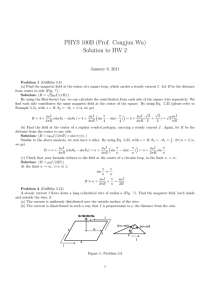PHYS 100B (Prof. Congjun Wu) Solution to HW 1 January 8, 2011

PHYS 100B (Prof. Congjun Wu)
Solution to HW 1
January 8, 2011
Problem 1 (Griffiths 5.3) In 1897 J. J. Thomson ”discovered” the electron by measuring the charge-to-mass ratio of ”cathode rays” (actually, streams of electrons, with charge q and mass m) as follows:
(a) First he passed the beam through uniform crossed electric and magnetic fields E and B (mutually perpendicular, and both of them perpendicular to the beam), and adjusted the electric field until he got zero deflection.
What, then, was the speed of the particles (in terms of E and B )?
Solution: ( v =
E
B
.
)
Let’s set coordinates as shown in fig.1: x : the direction of the beam, y : the direction of electric field E , z : the direction of magnetic field B .
From Eq. 5.2,
F = q [ E + ( v
×
B )]
To make sure the charge will not be deflected in the y direction, the electric force F
E
F
B
= q v
×
B need to be balanced,
F = 0
⇒
E =
−
( v
×
B ) .
= q E and the Lorentz force
This gives the desired relation between the speed of the particles and the magnitude of E and B v =
E
B
.
(b) Then he turned off the electric field, and measured the radius of curvature, R , of the beam, as deflected by the magnetic field alone. In terms of E, B , and R , what is the charge-to-mass ratio ( q/m ) of the particles?
Solution: ( q m
=
B
E
2 R
.
)
Figure 1: Problem 5.3
1
When the electric field is turned off, the particle only feels the Lorentz force which is always perpendicular to the velocity of the particles and gives the central force for the cyclotron motion of the electron. We have mv
2
R
= qvB
⇒ q m
= v
BR
.
Using the result of question (a), the charge-to-mass ratio ( q/m ) of the particles is q m
=
E
B
BR
=
E
B 2 R
.
Problem 2 (Griffiths 5.39)
A current I flows to the right through a rectangular bar of conducting material, in the presence of a uniform magnetic field B pointing out of the page.
(a) If the moving charges are positive , in which direction are they deflected by the magnetic field? This deflection results in an accumulation of charge on the upper and lower surfaces of the bar, which in turn produces an electric force to counteract the magnetic one. Equilibrium occurs when the two exactly cancel. (This phenomenon is known as the Hall effect .)
Solution: If the moving charges flow to the right, they are deflected down, and the bottom plate acquires a positive charge.
(b) Find the resulting potential difference (the Hall voltage ) between the top and bottom of the bar, in terms of B , v (the speed of the charges), and the relevant dimensions of the bar.
Solution: qvB = qE
⇒
E = vB
⇒
V = Et = vBt , with the bottom at higher potential.
(c) How would your analysis change if the moving charges were negative ? [The Hall effect is the classic way of determining the sign of the mobile charge carriers in a material.]
Solution: If negative charges flow to the left, they are also deflected down, and the bottom plate acquires a negative charge. The potential difference is still the same, but this time the top plate is at the higher potential.
Problem 3 (Griffiths 5.43)
Consider the motion of a particle with mass m and electric charge q e magnetic monopole q m at the origin:
B =
µ
0
4 π q m
ˆ .
r 2 in the field of a (hypothetical) stationary
(a) Find the acceleration of q e
, expressing your answer in terms of q, q m
, m, r (the position of the particle), and v (its velocity).
Solution: a = q e m
( v
×
B ) =
µ
0 q e q m mr 2 v
×
ˆ .
4 π
(b) Show that the speed v =
| v
| is a constant of the motion.
Solution: Because F
⊥ v , a
· v = 0 .
But a
· v = (1 / 2)( d/dt )( v
· v ) = (1 / 2)( d/dt ) v 2
(c) Show that the vector quantity
Q
≡ m ( r
× v )
−
µ
0 q e q m
4 π
= vdv/dt.
So dv/dt = 0.
is a constant of the motion. [Hint: differentiate it with respect to time, and prove—using the equation of motion from (a)—that the derivative is zero.]
Solution: d dt
Q = m ( v
× v ) + m ( r
× a )
−
=
=
=
=
µ
4
µ
µ
µ
0
π
0
0
0 q
4 q q
4 q e e e
π e
4 π
π r q q q q
2 m m m m
[
[
[
( r r r
1
1
−
3
3
× r
1
( v
− r ( r
· v )
)
( − r ( r · v )) +
3
( r v
2
×
ˆ ))
− r ( r
· v ) + r
µ
µ
0 r
3
0
2 q
4 q e r r e
π
4 π
3 q m q m
− d v r
( r
+
· r r r 2
]
)
( r
· v ) d v r r r
−
= 0 r dr r d
2
√ dt r · r dt
)
]
2
(d) Choosing spherical coordinates ( r, θ, ϕ ), with the polar ( z ) axis along Q ,
(i) Calculate Q
· ˆ
, and show that θ is a constant of the motion (so q e moves on the surface of a cone—something
Solution: ˆ
· ˆ
= r
· ˆ
= 0 .
Q
· ˆ
= Q z
· ˆ
= 0 .
On another hand,
Q · ˆ
= m ( r × v ) · ˆ −
µ
0 q e q m
4 π
ˆ ·
= m ( r
× v )
·
= m ( r ˆ )
× r ˆ + r θ
˙ ˆ
+ r sin θ ϕ
ˆ
)
)
·
= mr
2
θ
˙
⇒ r 2 ˙
= 0 true for arbitrary r . Therefore,
θ
˙
= 0 .
(ii) calculate Q
·
ˆ , and show that the magnitude of Q is
Q =
µ
0
4 π q e q m cos θ
;
Solution: Assume Q along the positive direction of ( z ) axis,
Q cos θ = Q
·
ˆ = m ( r
× v )
· r
−
µ
0 q e q m
4 π
ˆ
· r =
−
µ
0 q e
4 π q m
.
⇒
Q =
−
µ
0
4 π q e q m
.
cos θ
The magnitude of Q is
(iii) calculate Q
·
θ
µ
0
4 π q e q m cos θ
.
, show that dϕ
= dt k r 2
, and determine the constant k .
Solution:
−
Q sin θ = Q
·
(
ˆ
= m ( r
× v )
·
= m
ˆ −
)
( r ˆ )
×
( r sin θ ϕ
ˆ
)
·
µ
0 q e q m
4 π
ˆ
·
ˆ
=
− mr
2
ˆ
= m ( r
× v )
· sin θ
˙
=
Q 1 m r 2
= −
µ
0 q e q m
4 πm cos θ
1 r 2
.
k =
Q m
=
−
µ
0 q e q m
4 πm cos θ
.
(e) By expressing v 2 in spherical coordinates, obtain the equation for the trajectory, in the form dr dϕ
= f ( r )
(that is: determine the function f ( r )).
Solution: From (d) i) and iii), we have v
2 r
2
+
( r θ
˙
)
2
+
( r sin θ
)
2
2
+
( k r sin θ r 2
)
2
⇒
˙
2
= v
2 − k
2 sin
2
θ
.
r 2
3
⇒
(f) Solve this equation for r ( ϕ ).
Solution: dr dϕ
= =
√ v 2
− k r 2 k 2 sin 2 r 2
θ
= r
√( vr
)
2 k
− sin
2
θ.
∫ r
√( vr k
) dr
2 − sin
2
θ
=
∫ dϕ.
ϕ
− ϕ
0
[ x ≡ vr/ ( k sin θ )]
=
=
=
1 sin θ
1 sin θ
1 sin θ
∫ r
√( dr vr k sin θ ∫ sec x
√
−
1 dx x 2 −
1 vr k sin θ
)
2
=
)
−
1
.
1 sin θ sec
− 1 x
⇒ r ( ϕ ) =
= k sin v
−
µ
0 q e q m
4
θ sec[( ϕ
− ϕ
0
) sin θ ]
πmv tan θ sec[( ϕ
− ϕ
0
) sin θ ] .
4





